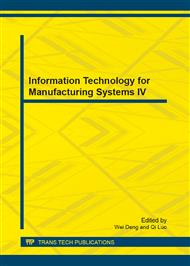[1]
C. T. Chang, L. Y. Wang, C. Y. Liao and S. P. Huang: Appl. Environ. Microbiol. Vol. 68(2002), p.3159.
Google Scholar
[2]
C. S. Bland, J. M. Ireland, E. Lozano, M. E. Alvarez and T. D. Primm: Appl. Environ. Microbiol. Vol. 71(2005), p.5719.
Google Scholar
[3]
USEPA: United States Environmental Protection Agency, Washington, D.C. (1999).
Google Scholar
[4]
U. H. K. Izhar and J. S. Yadav: J. Clin. Microbiol. Vol. 42 (2004), p.453.
Google Scholar
[5]
C. Le Dantec, J. P. Duguet, A. Montiel, N. Dumoutier, S. Dubrou and V. Vincent: Appl. Environ. Microbiol. Vol. 68(2002), p.5318.
DOI: 10.1128/aem.68.11.5318-5325.2002
Google Scholar
[6]
USEPA: United States Environmental Protection Agency, Washington, D.C. (2000).
Google Scholar
[7]
M. Dailloux, C. Laurain, M. Weber and P. H. Hartemann: Wat. Res. Vol. 33(1999), p.2219.
Google Scholar
[8]
J. H. Ahn, M. S. Kim, M. C. Kim, J. S. Lim, G. K. Lee, J. K. Yun, T. S. Kim, T. S. Kim and J. O. Ka: J. Microbiol. Biotechnol. Vol. 16(2006), p.704.
Google Scholar
[9]
K. H. Baek, B. D. Yoon, B. H. Kim, D. H. Cho, I. S. Lee, H. M. Oh and H. S. Kim: J. Microbiol. Biotechnol. vol. 17(2007), p.67.
Google Scholar
[10]
D. H. Ju, M. K. Choi, J. H Ahn, M. H. Kim, J. C. Cho, T. S. Kim, T. S. Kim and J. O. Ka: J. Microbiol. Biotechnol. vol. 17(2007), p.253.
Google Scholar
[11]
M. S. Kim, J. H. Ahn, M. K. Jung, J. H. Yu, D. H. Joo and M. C. Kim: J. Microbiol. Biotechnol. Vol. 15(2005), p.1087.
Google Scholar
[12]
T. C. Covert, M. R. Rodgers, A. L. Reyes and G. N. Stelma Jr: Appl. Environ. Microbiol. Vol. 65(1999), p.2492.
Google Scholar
[13]
G. Bussone, F. Brossier, L. Roudiere, E. Bille, N. Sekkal, C. Charlier, J. Gilquin, F. Lanternier, M. Lecuit, O. Lortholary and E. Catherinot: J Infect vol. 64(2012), p.613.
DOI: 10.1016/j.jinf.2011.12.020
Google Scholar
[14]
M. Govendir, T. Hansen, B. Kimble, J. M. Norris, R. M. Baral, D. I. Wigney, S. Gottlieb and R. Malik: Vet Microbiol. vol. 147 (2011), p.113.
DOI: 10.1016/j.vetmic.2010.06.011
Google Scholar
[15]
H. J. Jun, K. Jeon, S. W. Um, O. J. Kwon, N. Y. Lee and W. J. Koh: Respiratory Medicine vol. 103 (2009), p. (1936).
Google Scholar
[16]
M. Verregghen, H. G. Heijerman, M. Reijers, J. van Ingen and C. van Ent: J Cyst Fibros. Vol. 11 (2012), p.340.
DOI: 10.1016/j.jcf.2012.01.006
Google Scholar
[17]
B. Hafner, H. Haag, H. K. Geiss and O. Nolte: Mol. Cell. Probes vol. 18(2004), p.59.
Google Scholar
[18]
S. Park, G. Y. Suh, M. P. Chung, H. Kim, O. J. Kwon, K. S. Lee, N. Y. Lee and W. J. Koh: Respiratory Medicine vol. 102 (2008), p.437.
Google Scholar
[19]
A. Murai, T. Murakami, M. Inoue, H. Ueda, S. Shiihara, J. Kimura, A. Hirata, H. Sakai and T. Yanai: J Comp Pathol (2012), p.1.
Google Scholar


